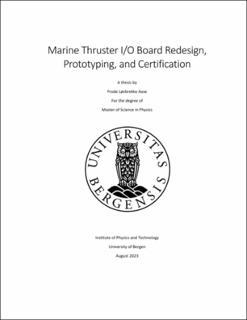Marine Thruster I/O Board Redesign, Prototyping, and Certification
Master thesis
Permanent lenke
https://hdl.handle.net/11250/3085326Utgivelsesdato
2023-08-01Metadata
Vis full innførselSamlinger
- Master theses [170]
Sammendrag
For about 20 years, the company Marine Technologies have used a circuit board called the IOB, which controls input and output signals. The Input Output Board (IOB) uses a logic device to manage the different signals. For the last 20 years this has been an FPGA (Field Programmable Gate Arrays). The manufacture, design, and supply of IOB belonged to another company, but the time came for Marine Technologies to claim the ownership of the IOB and make a design of their own. This was a good opportunity to make design changes and the possibility of using microcontrollers instead of FPGAs became an interesting pursuit. Microcontrollers naturally are cheaper and easier to acquire and have become considerably advanced, making them a possible replacement candidate. This thesis explores the process of implementing a microcontroller with the new IOB design and having the product certified. The new IOB must fulfill Marine Technologies’ set of demands which require it to be functionally identical to the original; it also needs to fulfill the international sets of standards that amongst other things set the demands for environmental robustness and Electromagnetic Compatibility (EMC) performance. To meet this set of demands, I completed an analysis of the current I/O usage of Marine Technologies’ systems and reduced the amount of I/O available to match this actual usage. This proved that a microcontroller have enough resources to handle the actual required I/O load of Marine Technologies’ systems. In terms of EMC, the best one can do is to design a circuit board that follows design guidelines for EMC as closely as possible and test it when the prototype arrives. The number one rule for EMC minded design, is to allow return currents to flow directly under the outgoing signal trace, which is best achieved by having dedicated, proper, and unbroken power and ground planes, placed in the layers between the top and bottom layer of the PCB. The design of the new IOB, called MT-IOB-Mk3-Transit, was done by closely examining the design of the previous two FPGA based iterations of the IOB, called the MT-IOB-Mk1 and MT-IOB-Mk2. The IOB-Mk3-Transit uses elements from both boards, by looking at 20 years of field testing and usage, what works best and what does not, while at the same time considering how the new microcontroller fits within these elements. In most aspects the IOB-Mk3-Transit is a mosaic containing elements from both the IOB-Mk1 and the Mk2, which are known to function reliably for 20 years. During functional testing of the IOB-Mk3-Transit, the crucial functions were working well. The board was tested in a certification lab in Italy, and due to the board being designed with sub optimal EMC practice, we used two attempts in Italy before finally passing the EMC tests, requiring some research at home before travelling for the second attempt. The product was then certified, installed on a vessel and is now in use. Taking the lessons learned from the IOB-Mk3-Transit, the new iteration purely called the MT-IOB-Mk3 has been designed, following the stated EMC guidelines closely to improve performance, and correcting a few minor issues of the IOB-Mk3-Transit. This board has yet to be tested. In the end, the question of using a microcontroller instead of an FPGA to perform the duties of the IOB, is only partially answered. Yes, the microcontroller can perform all the required functions that the FPGA did, and it will be implemented as a part of the Marine Technologies environment for now, but long-term reliability is a question that can only be answered by long-term use and testing.
